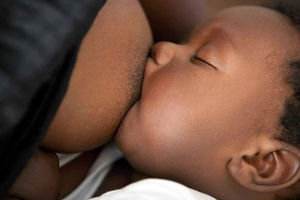
Breastfeeding is often romanticised as a beautiful, and instinctive process.
Breastfeeding is often romanticised as a beautiful, and instinctive process. But for many mothers, it is anything but straightforward.
Every night is almost always a repeat of the previous. A crying baby who needs to be fed frequently but cannot latch properly. Dealing with a low milk supply. Let us not forget sleep interruptions.
Contrary to popular belief, breastfeeding does not always come naturally. Speaking to Nation Lifestyle, two lactation experts shed light on the intricacies of mama’s milk, also known as liquid gold. They extensively discuss the breastfeeding journey and invaluable tips to boost the lactation experience.
Wangeci Kihara, a child nutritionist and certified lactation specialist at The Mothership Village in Nairobi says that at the heart of breastfeeding is trusting your body as a mother and getting the latch right.

Wangeci Kihara, a child nutritionist and certified lactation specialist at The Mothership Village.
"If you get it right, a lot is saved. Your milk supply will increase easily, and your baby's weight will go up easily."
To achieve a perfect latch, the rule of thumb is to have the tummy-to-tummy and nipple-to-nose position. This means the baby's tummy should be on mum's tummy and his/her nose to your nipple.
To get the best position for breastfeeding, a mum should consider the breast size and nipple shape, whether one has back issues or a caesarean scar, and the comfort level when sitting after a vaginal birth.
Want not to need
To maintain the milk supply at a steady high, breastfeeding mums have resorted to consuming lactation cookies and teas. These treats, Wangeci explains, have galactagogues, which support breast milk production. However, she does not advocate their use.
"If you support your body, it knows what to do. It is a want, not a need. For good milk production, you only need yourself and your baby. Everything else is a want and if you do not get the breastfeeding basics right, you will always have lower milk production when you remove the galactagogue," she says.
"It is like if you break your leg and go to the hospital, but the doctor gives you crutches without putting a cast on the broken leg. When these crutches are taken away, you will not be able to walk. When the cookies/teas are not there, you will panic and you will not have milk because the crutches are not there."
No milk supply?
According to Wangeci, the issue of low milk supply begins in the mind of the mum and the steps she takes to address the thought result in a low milk supply.
"It starts with the mind. If you believe it is normal not to have enough milk supply, you will attribute normal infant behaviour to inadequate milk. And that is not the truth,” she says.
There are only two key indicators of whether the baby is having enough milk; the number of wet diapers (at least six diaper changes in 24 hours) and the baby’s weight gain (hitting the correct percentiles from the birth weight).
Dos and don'ts

Ms Naomi Mwangi, a Lactation Manager at Aga Khan University Hospital.
Naomi Mwangi, a lactation manager at the Aga Khan University Hospital shares that for lactation to be successful, a mother should strive to concentrate fully when breastfeeding.
"You should not have interference; your phone should be silent. Focus on the baby and the breast because you need to know each other. Create a rapport by talking to them… 'how did you sleep, what did you dream of, it's time for feeding. Even if they do not respond or they murmur keep talking."
Secondly, you should not keep the baby very warm.
"Leave the sensitive areas (feet, armpits, tummy) accessible so that the baby is alert and can nurse for longer periods around 20 to 30 minutes on each breast."
In the first 10 minutes, the baby takes foremilk (watery), the rest of it is the hind and it is very fatty, helps the baby gain weight and it is more satisfying.
Naomi also urges mothers not to let their babies to sleep for more than three hours so that they can feed. "Mothers breast milk is easily digestible so after three hours there is nothing in the tummy. Babies should feed for 8 to 12 times a day."
Naomi advises mothers to learn the personality of their babies to understand their likes and dislikes so that they do not interfere with feeding. For instance, some babies cannot nurse when the diaper is soiled.
"If you get to know that after the diaper change the baby nurses very well…that baby is communicating. Others do not like noise. They are just small humans but I think their minds are like adults."
When nursing, the baby should not make any clicking sounds, or deep dimples and the mother should not feel pain. If any of the three is experienced, Naomi notes that the baby might not feed enough, have gas or the mother will have sore nipples.
It is natural for a mother to put the interests of the baby first but experts advise the opposite. If the mother is not comfortable, is in distress, or pain, has anxiety, she is stressed or exhausted, she may not be able to take care of the baby.
Naomi points out, "For her to know she is reaching the tipping point, she starts funnily, she does not finish her food, or the cup of porridge, soup. She will keep on pushing her plate and cups aside so as to take care of the child. It is for this reason that new mothers should be accorded maximum support and their meals are not interfered with. If you have a partner, they should pick the baby and calm them as mom finishes to eat or freshen up."
Breastfeeding positions
The most common is the cradle, popularly known as tummy to tummy. In this position, Naomi says just as the name suggest, the baby's tummy faces mum's tummy.
"The baby's arm should be under the breast; the head should be at the arm of the mother with her hand covering the baby's buttock. You should only see one of the baby's arms, so the baby is lateral. If you've got the position right, the baby's mouth lands on the nipple. After that, just lift your breast for a deep latch of the areola in the baby's mouth."
Though many right-handed mothers struggle to breastfeed with their right boob, Naomi shares that they can still use the cradle position or use the American football hold if push comes to shove.
"You tuck in the baby under your arm and hold their neck for support. With this position, a mother only uses one hand and can support the hand holding the baby by adding a baby's shawl. Mothers with twins can also use the position to nurse," she explains.
The last position is the side-lying which is advisable for mothers who have more expertise with breastfeeding. In this position, the mother and the child should lie laterally and she should only breastfeed the bottom breast. Never the top.
"If the baby is done with the bottom breast and wants more, the mother and baby should lie on the other side and nurse."
Inverted nipple
Even before delivering, Naomi advises that expectant mothers should have a nursing pillow/poofi as it prevents mothers from bending to reach the baby and also prevents arm fatigue by supporting the baby's weight on the pillow.
Additionally, depending on the breast shape whether flat or inverted nipples, a mum can use a medela nipple former. "For a mother with the inverted nipple, she can put the nipple in the hole and wear a bra. Because of the pressure of the brassiere, the nipple will be elongated inside the disk. You can prepare the nipple while you are pregnant or immediately after the baby is born," she explains.
Another gadget mums can use is a nipple puller. Naomi points out that you can use the puller once the baby is delivered. "The nipple puller is used to inflate the nipple and once done, you can wear a bra. This way, when the baby is ready to suckle, they can find a formed nipple."
Nonetheless, when the mother is unable to get the baby to latch through the puller and former, Naomi okays the use of nipple shields. It is an artificial teat which has a flap that attaches to the skin of the breast. "Where there is a flat nipple, you can attach the shield on top and you are able to introduce the artificial teat in the mouth of the baby. When they start suckling, your nipple will elongate and get inside the teat."
This is the first part series on Breastfeeding, to mark World Breastfeeding Week which kicks off tomorrow. It has been marked since 1992 and aims to raise awareness of the importance of breast milk in promoting children’s health. This year’s theme is Closing the Gap: Breastfeeding Support for All.









